Death of a professor: Changing Kashmir’s narrative?
The events which have unfolded in the recent past reflects that there is no way of abandoning the arms resistance path
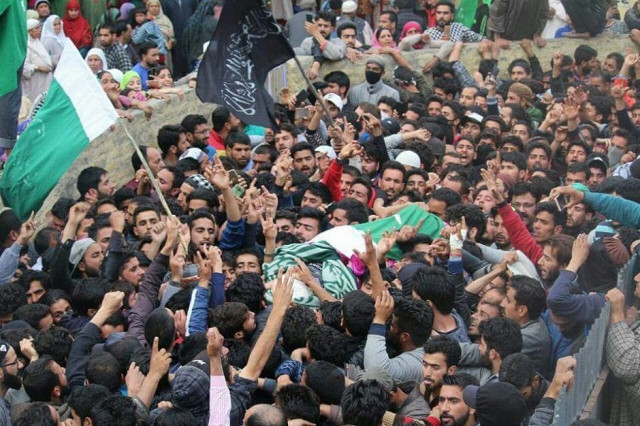
A month ago, on May 6, Indian-Occupied Kashmir witnessed what could be told to be a stark reminder of how far the struggle for freedom has gone. In one of the most violent days in IoK, 10 Kashmiris were shot dead by Indian forces during a clash. While the death toll resulted in the breaking out of a massive protest, it also broke the divide between freedom fighters and educated civilians. Among the dead was a 32-year-old professor from the University of Kashmir.
On the afternoon of May 4, Dr Mohammad Rafi Bhat didn’t return home after he taught sociology to students at the university. Just 36-hours later, he was killed, for being part of a group of freedom fighters.
Six more youth martyred by Indian forces in IOK
The uncertainty of where this could lead the Valley was felt by everyone. And Dr Rafi’s residence on the day of his funeral was reminiscent of this uncertainty. As I walked deep inside the houses traversing through lanes and by-lanes to reach his residence, I could hear sighs amid cries around but it was unlike any other mourning.
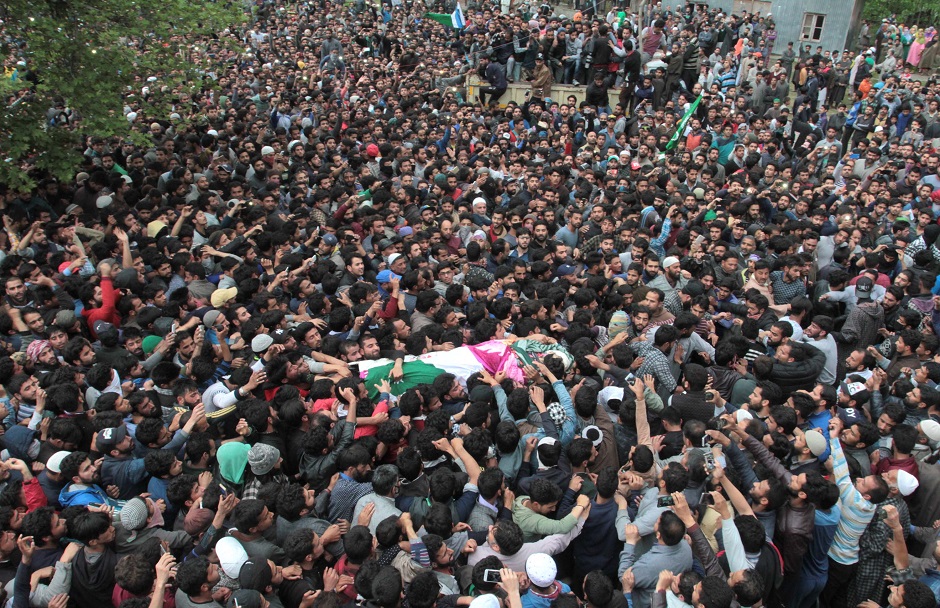 Tens of thousands of people visited Professor Mohammad Rafi Bhat’s house to sympathise with the family. Photo credit: Shuaib Masoodi
Tens of thousands of people visited Professor Mohammad Rafi Bhat’s house to sympathise with the family. Photo credit: Shuaib Masoodi
People were changing their places sitting inside a make-shift tent to make space for those coming to pay tribute to their fallen ‘soldier’.
Despite heavy rainfall and restrictions in place by the government forces, tens of thousands of people visited Rafi’s house to sympathise with the family. The scenes at the residence were gloomy: students made a beeline to pay tributes to their beloved teacher, others expressed their surprise as the teacher had never desired to take up arms though he was ‘resistance conscious’. Close relatives of Rafi consoled his father, Abdul Rahim Bhat. “My son was tehreekpasand,” he said of Rafi, a freedom-lover.
Rafi’s last call to his family: ‘I’m sorry if I [have] hurt you! I shall meet in hereafter’. Still rings in the ears of his mother, who he had called, while Iqra, his young wife finds it hard to come to terms with her husband’s sudden death.
“He was all mine; my friend, my father, my mother. He would treat me like a kid… he used to share everything with me and we took every decision together. How can I explain to you how much we loved each other,” says Iqra, as tears roll down her cheeks. “I don’t know why he took this decision all-alone,” she adds.
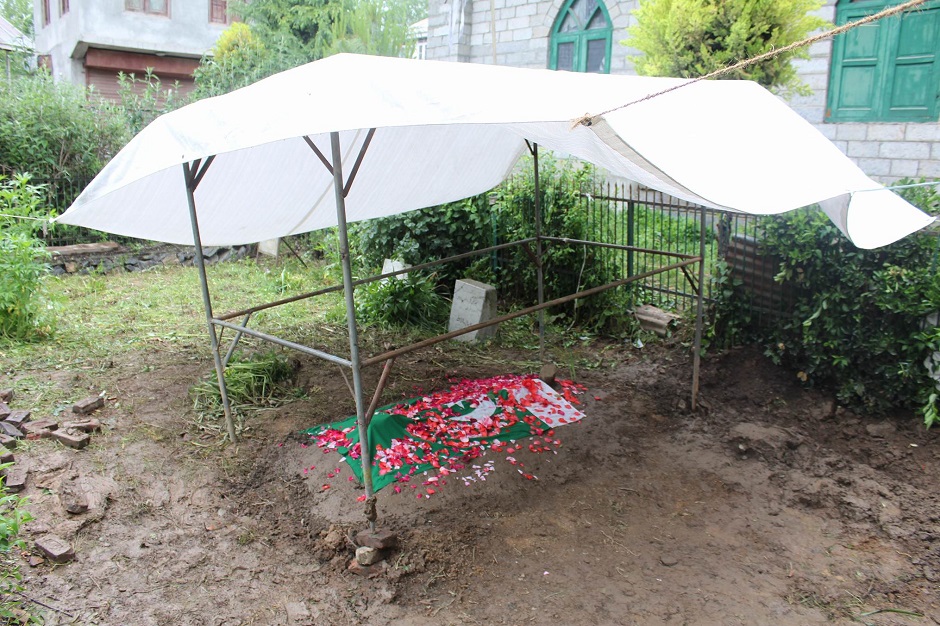 Professor Rafi's grave in his village Chunduna, Ganderbal. Photo credit: Imran Illahi
Professor Rafi's grave in his village Chunduna, Ganderbal. Photo credit: Imran Illahi
Rafi married Iqra three years ago but they did not bear any children.
“Rafi purposefully did not speak to me [about his decision to join freedom fighters],” Iqra murmurs amid sobs. “He knew I was his weakness and I would not have let him die if he spoke to me,” she says and breaks down.
Rafi was like any other Kashmiri, disturbed and anguished by the prevailing situation in Kashmir. But he didn’t discuss anything which would have given his family any idea about his decision.
Five Kashmiris martyred by Indian troops in IOK
He had left the Department of Sociology at 3pm on Friday, May 4, and when he did not reach home his family members had lodged a missing report on the following day. The very next day, he was killed.
“Our family received a call from the SSP Shopian during the gun-fight,” recalls Iqra. “I told the cops that Rafi would not listen to anyone except me. My family begged with the SSP to wait till we reach the [encounter] site and I would talk to Rafi myself but they had killed him [before we reached],” she adds.
Although Iqra doesn’t wish for any other wife to feel her pain, she believes that with the worsening situation in the Valley, women will also be compelled to pick-up arms.
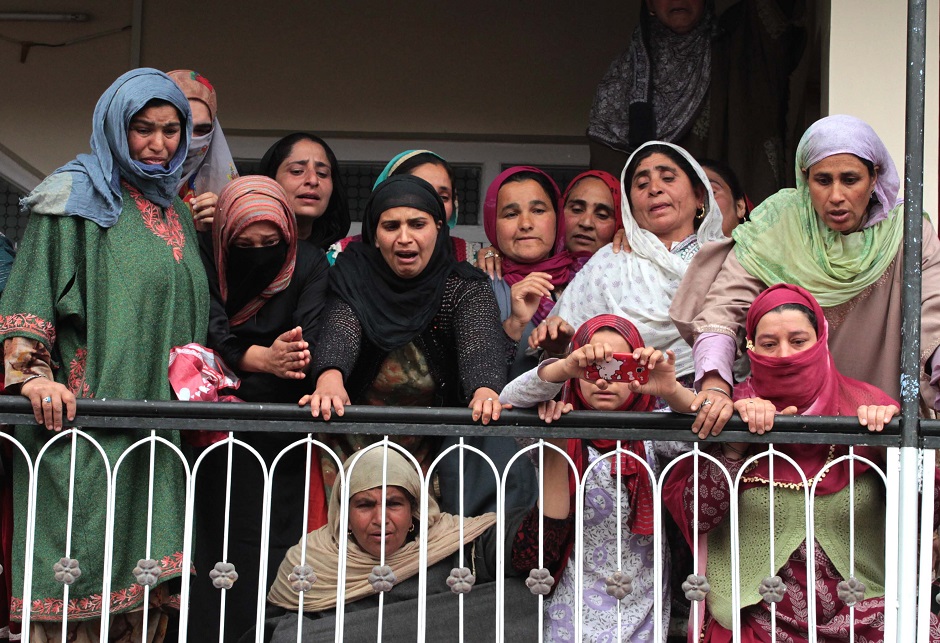 Women mourn during the funeral procession of lecturer Mohammad Rafi Bhat who was killed at an encounter in Shopian on May 6. Photo credit: Khalid Khan
Women mourn during the funeral procession of lecturer Mohammad Rafi Bhat who was killed at an encounter in Shopian on May 6. Photo credit: Khalid Khan
A storm after the calm
Kashmir has seen deadly encounters this year. At least 114 people have been killed in militancy-related violence in the Valley in the first four months of 2018. Among them, 53 were fighters from Hizbul Mujahideen, Lashkar-e-Taiba and Jaish-e-Mohammad; 33 civilians, 14 policemen, 13 Indian army men and one right-wing BJP worker.
Professor Rafi’s decision to join the freedom fighters may not be surprising as Kashmir witnessed hordes of youth joining fighting ranks soon after militant commander Burhan Wani died fighting Indian soldiers in July 2016. His death triggered a massive anti-India uprising that resulted in deaths of over 100 civilians and injuries to nearly 10,000 others, 200 of whom were blinded.
However, Rafi’s hometown, district Ganderbal, in central Kashmir remained calm even at the peak of 2016 anti-India uprising. In fact, Chunduna, his native village, is popular for its good literacy rate and people mostly remain busy working in their fields while a significant number are employed in the government sector.
Rafi was perhaps the first to don the hat of a fighter in this region. According to a report, Rafi wanted to revive militancy in his area. However, he was not the first among his family to join the anti-India armed rebellion. Two of his cousins, who were freedom fighters, were killed in the early 1990s.
Rafi was part of a group of five freedom fighters who were caught in a massive military raid during the intervening night of May 5 and 6 in a village in southern district of Shopian. Among others was popular militant commander, Saddam, who was a close confidante of Burhan Wani.
“In a state where even the policemen can become militants, teachers are not a surprise. It means that there is something wrong in our educational system as well,” says noted novelist and academic, Shahnaz Bashir.
Kashmir — finding the way forward
Third among his siblings, Rafi was awarded PhD in 2017 and had qualified in all top academic examinations in his subject. He was about to appear in an interview in a Hyderabad varsity in mainland India. But he died before he could appear for the interview, sending shockwaves among academics in the Valley.
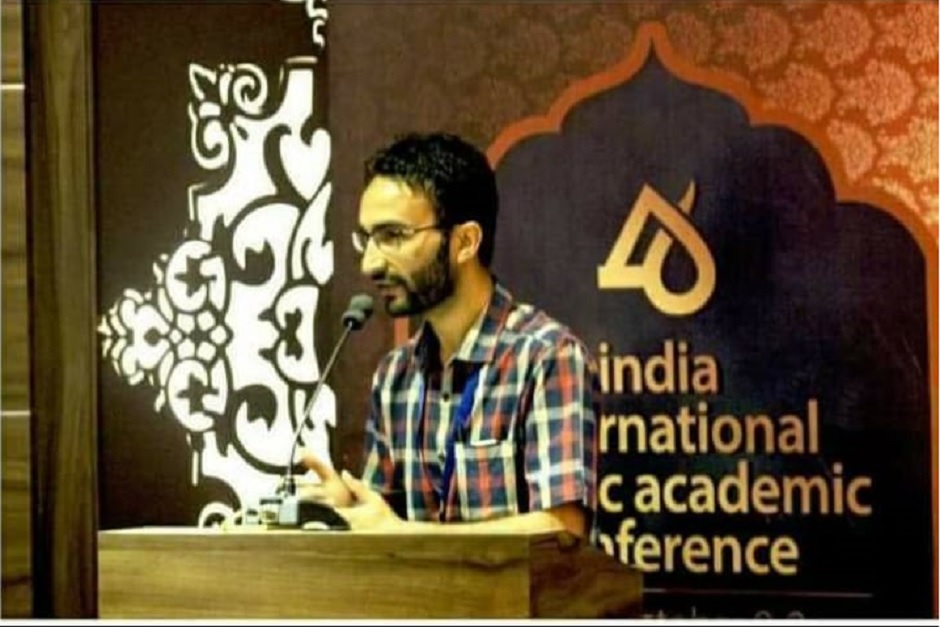 Professor Mohammad Rafi at an academic conference. Photo credit: Facebook
Professor Mohammad Rafi at an academic conference. Photo credit: Facebook
"Youth, specifically educated and those from well-off families joining militant ranks speaks of the acceptability of arms resistance amongst the Kashmiri populace," says a Kashmiri scholar of international relations on the basis of anonymity. At least 45 youths have joined militancy in 2018, so far.
According to Professor Mehrajud Din, the vice chancellor of the Central University of Kashmir, due to the current circumstances in the Valley the youth are being pushed towards militancy. “He [Rafi] was a doctorate, a Junior Research Fellow and was the best teacher… we have lost an asset,” he adds.
The rising number of youth taking up arms had already concerned academics, but many now believe that Professor Rafi has set a bad precedent. “Instead of providing a solution, we have seen that such educated people have become points of reference for others,” says the vice-chancellor.
“Such a trend will impact students. Teacher counsel students against the things which give rise to violence but when a teacher himself takes such a step, it is very distributing,” he adds.
However, others also believe that the state has a part to play in the growing militancy among youth. “If a qualified professor from a reputed university, coming from a well-off family is picking up arms for addressing the issues that means something is grossly wrong. It means that this is neither a social nor an economic issue but a political issue,” says Professor Mushtaq A Siddiqi, the vice chancellor of Islamic University of Science and Technology.
The events which have unfolded in the recent past reflects that there is no way of abandoning the arms resistance path in Kashmir as India has only used violent means to suppress the genuine struggle for right to self-determination, opines the international relations scholar.
A unilateral but conditional ceasefire announced by Prime Minister Narendra Modi on May 16 for the holy month of Ramazan has already witnessed a number of civilian deaths. Four girls were injured, two critically, on May 22 when the army opened fire in South Kashmir. Just three days after that, on May 25, 70 people were seriously injured when the IoK Police and paramilitary forces fired pellets after the Friday prayers in Srinagar; permanently blinding at least 10 people. On May 28th, the army killed a civilian bystander in retaliation of freedom fighters attacking a security force camp in south Kashmir.
The ceasefire agreement between Pakistan and India was also violated within 72-hours of its passing. On June 1, Indian troops shot at and injured a 25-year-old man in a border village of Azad Jammu and Kashmir only three days after the top military officials of both the countries agreed to fully implement the ceasefire agreement of November 2003.
LoC clash breaks lull in nascent ceasefire
New Delhi and Islamabad should think about it and resolve the issue forthwith, demands Prof Mushtaq. “Since I have direct contact with students I can say the present mood of the students is very angry… They feel desperate and hopeless,” he exclaims. “New Delhi should stop seeing Kashmir as a law and order problem and resolve it politically,” he suggests.
 The rising number of youth taking up arms had already concerned academics, but many now believe that Professor Rafi has set a bad precedent. Photo credit: Sameer Yasir
The rising number of youth taking up arms had already concerned academics, but many now believe that Professor Rafi has set a bad precedent. Photo credit: Sameer Yasir
Sociologist Peerzada Amin also echoes Professor Mehrajud Din’s sentiments and thinks Professor Rafi could become the reference point for students. “The kind of environment in which people are living in Kashmir, there are vulnerabilities of the youth to fall in[to militancy]. It all depends on what kind of environment are we offering as parents, heads of institutions and as a society to the students,” worries Amin.
He further opines that the state should not underestimate the situation and it needs to ensure that the situation doesn’t get out of control. “It’s now up to the state to address the issues,” says Amin.
As for the Valley's first fighting professor, Amin adds that he knew Rafi for the past 11 months. "He was a decent boy and professionally sound. I never saw this kind of tendency in him. He was doing his job seriously,” he says.
For Rafi’s mother, who sat among neighbours and relatives, the 32-year-old professor had achieved everything in his life, "so many degrees." “I never expected him to take this step. ‘Mom, we shall meet on the day of Judgment,’ he told me in his last call while I could hear loud bangs and gunshots in the backdrop. My heart was beating fast. No mother wants to see her children die like this,” she says.
The author is a Srinagar based Journalist and tweets @AuqibBinJavaad

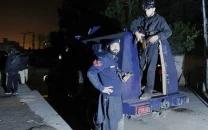
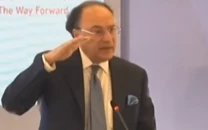
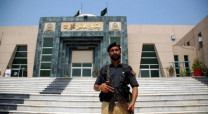

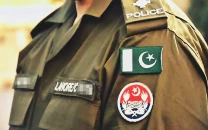
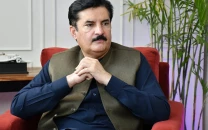












COMMENTS
Comments are moderated and generally will be posted if they are on-topic and not abusive.
For more information, please see our Comments FAQ